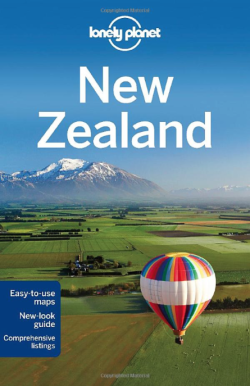Whale Watching
The country has a distinctive array of animal and plant species, and one of the more popular sights to behold in this country are the presence of whales. It is a breathtaking sight to behold; these smart and gigantic aquatic creatures at close proximity will definitely complete your New Zealand stay.
New Zealand revels in its position as prime whale-watching country. There are whale-watching package deals that you can participate and enjoy, and most of these offers can be booked online.
To help you with your plans, this article will discuss the best spots for watching whale activity in NZ, the best times to look for it and the different species that usually linger in the country’s coasts throughout the year.
Places to Watch Whales
-
Kaikoura
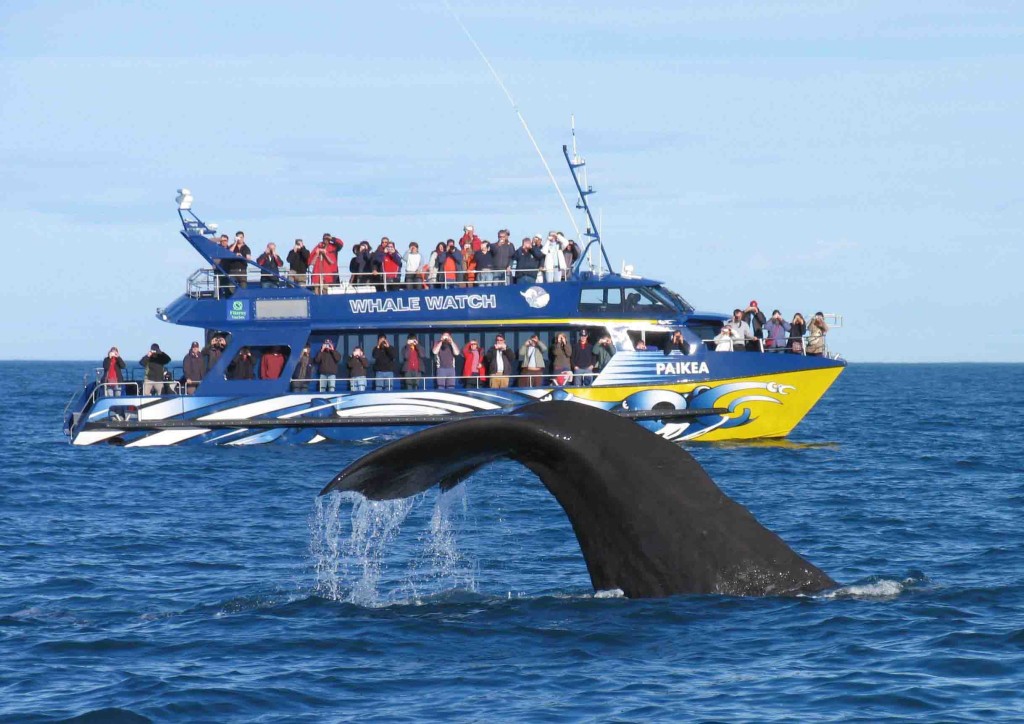 Kaikoura is located in the east coast part of the South Island. It is roughly 150 kilometers north of Christchurch and the area is included as one of the few places around the globe where people can easily spot sperm whales.
Kaikoura is located in the east coast part of the South Island. It is roughly 150 kilometers north of Christchurch and the area is included as one of the few places around the globe where people can easily spot sperm whales.
These aquatic creatures swim deep into the depths of the ocean to get nourishment and its population can be seen in the area throughout the year. On a whale watching boat trip you will spot the humpback species in the months of June and July while the orca can be witnessed at play from December down to March. The place is also known for its dolphin sightings.
Kaikoura has a rich and unique submarine environment, with a continental shelf that dips down into several cavernous canyons located further below. The south’s cold current merges with the north’s warm ones and this occurrence makes nutrients from the ocean’s depths to be transported towards the surface. This process sustains marine life and provides food for the dolphins and whales.
-
Hauraki Gulf
Hauraki Gulf is a marine park that is situated in the vicinity of Auckland. The gulf has been a habitat of approximately 22 kinds of dolphins and whales which are protected by New Zealand’s Marine Mammals Protection Act.
The humpback species can be seen passing by during the summer and winter while the Bryde species can be seen several times a year. The orca meanwhile passes by on the Hauraki Gulf every so often as a pod with 5 up to 15 whales.
-
Bay of Islands
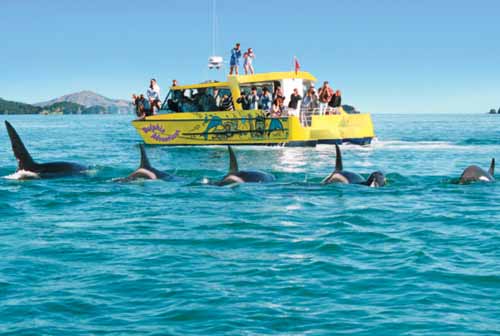 The Bay of Islands can be found in the far north area of the North Island and in here you will see bottlenose dolphins throughout the year.
The Bay of Islands can be found in the far north area of the North Island and in here you will see bottlenose dolphins throughout the year.
There is a variety of sea mammals seen here, mostly the orca from March down to August. During the snowy season, expect to witness the humpback species migrating by way of the islands.
Whale Species in New Zealand
 As we all know, whales are the biggest animals known to man. New Zealand covers half of the globe’s dolphin and whale species and you will witness most of these mammals in different coasts in the country.
As we all know, whales are the biggest animals known to man. New Zealand covers half of the globe’s dolphin and whale species and you will witness most of these mammals in different coasts in the country.
There are two families of these particular sea mammals and they are the toothed whales and the baleen whales. The former consists of species with teeth and they employ the process of echolocation to hunt down their prey. Foremost examples of this kind are the dolphins, pilot whales and sperm whales found on NZ.
Baleen whales meanwhile are species with baleen discs perched on the roof of their jaws. It helps in sucking large quantities of krill from the water which acts as food for the species. Normally they are bigger in size as compared with the toothed species and New Zealand has the humpback and Southern right whales as prime examples.
Here is a small list plus added information about these wonderful sea creatures that you will see in New Zealand:
-
Killer whale (Orca)
 It is the biggest species in the family and can be distinguished from the pack by its unique black and white patterns and heightened, protruding dorsal fin. This aquatic mammal can develop up to 9 meters in length. Its flippers are usually big and shaped like a paddle and the body is normally stout and strong.
It is the biggest species in the family and can be distinguished from the pack by its unique black and white patterns and heightened, protruding dorsal fin. This aquatic mammal can develop up to 9 meters in length. Its flippers are usually big and shaped like a paddle and the body is normally stout and strong.
Orcas are smart and energetic, they are renowned for their flipper-slapping and jumping and diving gestures. Males are typically larger and longer than females and the latter often feature smaller flippers and more rounded dorsal fins.
They like to swim in deeper waters but they can also be spotted swimming in inlets. They can be found venturing Wellington for a particular food resource and traveling in pods to places like the Kapiti Coast.
-
Blue whale
 The blue whale is considered as the largest animal in the animal kingdom. There is a sizable blue whale population in New Zealand, but whether the species stays for an extended period or just passes by in the area remains unknown. In 2014 though, marine biologists have discovered a foraging ground in the South Taranaki Bight.
The blue whale is considered as the largest animal in the animal kingdom. There is a sizable blue whale population in New Zealand, but whether the species stays for an extended period or just passes by in the area remains unknown. In 2014 though, marine biologists have discovered a foraging ground in the South Taranaki Bight.
The species are known to be solitary creatures and unlike other sea mammals, doesn’t use echo location to travel through. However, they are distinguished by their noisy, strong vocalizations.
The species are protected by the International Whaling Commission due to their dwindling numbers.
-
Humpback whale
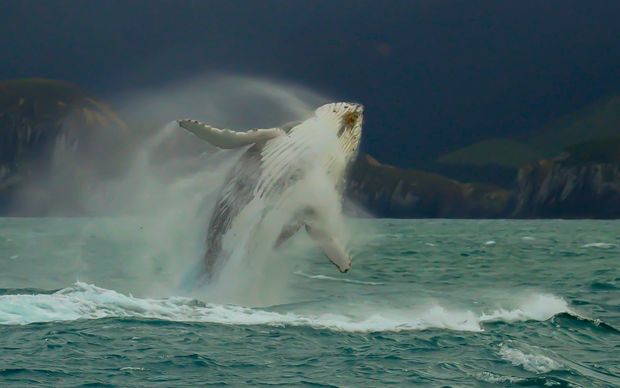 This certain aquatic mammal is popular due to their complicated yet stunning songs and breaching acts. This specie has lengthy flippers and a small dorsal fin with a characteristic bulge or hump located at the front. It also has bumpy bulges on its head and distinctive black and white markings.
This certain aquatic mammal is popular due to their complicated yet stunning songs and breaching acts. This specie has lengthy flippers and a small dorsal fin with a characteristic bulge or hump located at the front. It also has bumpy bulges on its head and distinctive black and white markings.
It is protected by the Department of Conservation and their surveys denote the current condition and recovery level of the species in the coasts of New Zealand. The research will also show the species’ migratory activities, their routes and destinations. The data will be collected and employed for managing the species and further safeguard them in the area.
-
Southern right whale
 This sea mammal has a characteristic lack of dorsal fin, a blowhole spray formed into a V and it also has a tough, rounded mouth. The species’ head and lower jaw have big, rough bumps that are pale in color and these bumps are normally ridden with parasitic barnacles, worms and lice.
This sea mammal has a characteristic lack of dorsal fin, a blowhole spray formed into a V and it also has a tough, rounded mouth. The species’ head and lower jaw have big, rough bumps that are pale in color and these bumps are normally ridden with parasitic barnacles, worms and lice.
The species are normally black-colored and also have uneven white spots. They have big, paddle-shaped flippers but are sluggish swimmers as compared with other whales. However, they can be acrobatic and curious in nature.
They can be found migrating to Auckland and the Campbell islands during the winter and spring seasons but they were also spotted passing around the mainland’s coasts. As of late, the species’ population seems to be rising and this improvement has been linked to the Auckland Islands marine mammal reservation.
-
Sperm whale
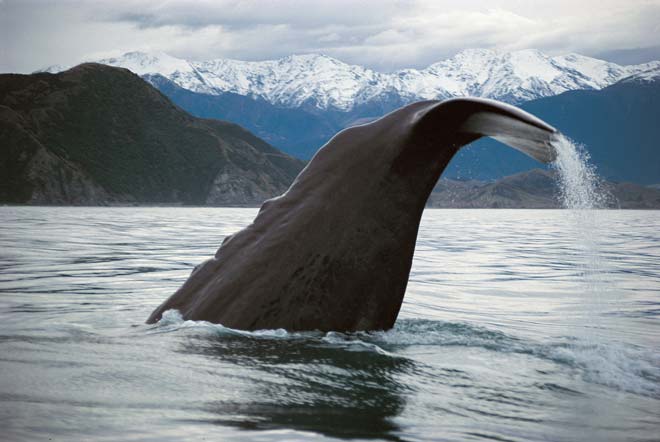 The sperm whale can be identified through its creased skin and sizable, seemingly square head which rounds out 1/3 of its body measurement. Males are typically bigger than the females, which have a smaller, even heads.
The sperm whale can be identified through its creased skin and sizable, seemingly square head which rounds out 1/3 of its body measurement. Males are typically bigger than the females, which have a smaller, even heads.
They are either grey or brownish-purple in color with some whites on their bottom. The species’ dorsal fin looks like a stumpy bump and it has a single, slash-like blowhole which can be found on the snout’s top left part.
They like swimming into deep waters and were often spotted in places like Kaikoura. They can be seen in that area throughout the year.
Whales: Approach with Caution
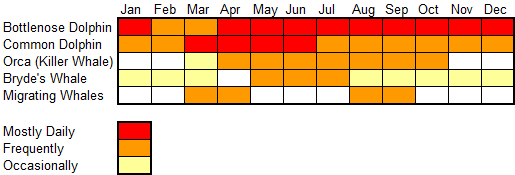 Whales, unlike their more dangerous counterparts like the shark, are no threat to humans, but still common sense rules must be used once you embark on a surfing or boating trip in an area frequented by these aquatic creatures.
Whales, unlike their more dangerous counterparts like the shark, are no threat to humans, but still common sense rules must be used once you embark on a surfing or boating trip in an area frequented by these aquatic creatures.
Here are some rules that you have to keep in mind in order to reduce disturbance and keep risks away:
- Better reduce your speed and stop if a whale moves towards your boat.
- Only three boats or vessels are allowed within 300 meter of any aquatic animal.
- Do not impede a whale’s trail. Operate your boat considerately.
- Be sure to keep your distance a good 50 meters away from the pack. If you happen to come across a mother whale and her offspring, keep your distance by at least 200 meters.
- Swimming with the animal is not encouraged.
- Prevent any abrupt noises or disturbances that could frighten them.
- If you have people with you, work as a team so they can also see the animals minus the danger.
- Maintain clean surroundings as this can affect marine life. Throw any sort of garbage in its proper containers. Plastic is one material that can pose not only environmental risks but health risks on aquatic animals so make sure that you dispose plastic containers appropriately.
- If you happen to observe nets employed inside protected zones, you should quickly contact the Ministry of Primary Industries.
- Remember that you have a legal duty to report to the Department of Conservation and Ministry of Primary Industries within 48 hours if you catch or endanger a whale by accident.
Getting up close and personal with these giants of the sea is definitely a once in a lifetime experience and New Zealand is one of the best places in the world to meet them.
New Zealand is a country that is popular with travelers and backpackers from all over the world because of its picturesque natural attractions, its vibrant Maori culture, exciting activities, friendly and welcoming locals and impressive flora and fauna. Respect the nature and New Zealanders and enjoy your stay!


